Fontenay-le-Comte
Fontenay-le-Comte (IPA: [fɔ̃tənɛ lə kɔ̃t]) is a commune in the Vendée department in the Pays de la Loire region in France. It is a sub-prefecture of the department.
Fontenay-le-Comte | |
|---|---|
Subprefecture and commune | |
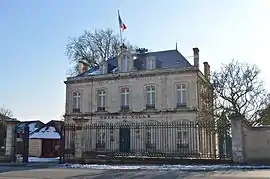 The town hall in Fontenay-le-Comte | |
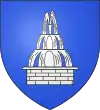 Coat of arms | |
Location of Fontenay-le-Comte 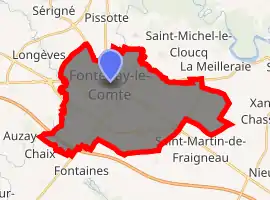
| |
 Fontenay-le-Comte 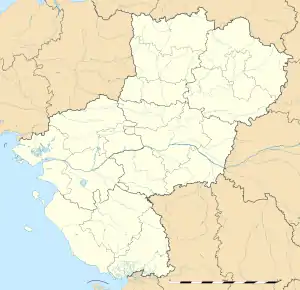 Fontenay-le-Comte | |
| Coordinates: 46°27′58″N 0°48′22″W | |
| Country | France |
| Region | Pays de la Loire |
| Department | Vendée |
| Arrondissement | Fontenay-le-Comte |
| Canton | Fontenay-le-Comte |
| Intercommunality | Pays de Fontenay-Vendée |
| Government | |
| • Mayor (2020–2026) | Ludovic Hocbon |
| Area 1 | 34.05 km2 (13.15 sq mi) |
| • Urban | 252.1 km2 (97.3 sq mi) |
| Population (2017-01-01)[1] | 13,226 |
| • Density | 390/km2 (1,000/sq mi) |
| • Urban (2017) | 26,806 |
| • Urban density | 110/km2 (280/sq mi) |
| Time zone | UTC+01:00 (CET) |
| • Summer (DST) | UTC+02:00 (CEST) |
| INSEE/Postal code | 85092 /85200 |
| Elevation | 2–68 m (6.6–223.1 ft) (avg. 24 m or 79 ft) |
| 1 French Land Register data, which excludes lakes, ponds, glaciers > 1 km2 (0.386 sq mi or 247 acres) and river estuaries. | |
Geography
The river Vendée flows through the town. The town has an area of 34 km2 (13 sq mi).
History
Fontenay was in existence as early as the time of the Gauls. The affix of comte is said to have been applied to it when it was taken by King Louis IX from the family of Lusignan and given to his brother Alphonse, count of Poitou, under whom it became capital of Bas-Poitou. Ceded to the Plantagenets by the Treaty of Brétigny, in 1360 it was retaken in 1372 by Duguesclin. It suffered repeated capture during the Religious Wars of the 16th century, was dismantled in 1621 and was occupied both by the Republicans and the Royalist Vendeans during the Revolt in the Vendée (1793). From 1790 to 1806 it was capital of the Vendée department.
Miscellaneous
At Maison Laval on rue Rabelais, a townhouse built at the end of the 18th Century, Emperor Napoleon 1st and his wife, Joséphine, spent the night of 7–8 August 1808. On their way from Rochefort to Nantes, they had stopped off in the Bas-Poitou capital of Fontenay-le-Comte where they were the guests of Mayor Laval who, to give them a dignified welcome, had prepared a triumphal arch over the Pont Neuf bridge. That night, the Emperor learned of the defeat of General Dupont at Bailem. The General's surrender, which seriously compromised the French army's position in Spain, threw the Emperor into a deep rage. If word is to be believed, the Emperor smashed an earthenware vase placed in front of him.
Personalities
- François Rabelais (1493–1553) was a Franciscan friar at Fontenay-le-Comte, where he studied Greek and Latin, as well as science, philology, and law.
- Georges Simenon (1903 – 1989) the Belgian writer, author of the Maigret series and other books, stayed at the Chateau de Terreneuve during the war. Several stories are based in the Vendee, and at least one in Fontenay. There is a Simenon tour.
Fontenay-le-Comte was the birthplace of:
- Barnabé Brisson (1531–1591), jurist and politician
- François Viète (1540–1603), mathematician
- Mathurin Jacques Brisson (1723–1806), zoologist and natural philosopher.
- Michel Crépeau (1930–1999), politician
- Jamy Gourmaud ( 1964-), journalist
- Frederic Mazella (1976-), an entrepreneur and funder of BlaBlaCar
Main sights
.jpg.webp) Notre-Dame church
Notre-Dame church.jpg.webp) Saint-Jean church
Saint-Jean church Quatre Tias' fountain
Quatre Tias' fountain Billaud house
Billaud house Museum
Museum François Viète's house
François Viète's house.jpg.webp) Rivalland tower
Rivalland tower
Twin towns - sister cities
Fontenay-le-Comte is twinned with:[2]
 Crevillent, Spain
Crevillent, Spain Diosig, Romania
Diosig, Romania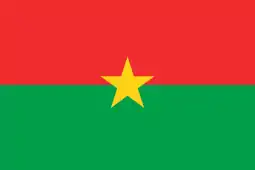 Gaoua, Burkina Faso
Gaoua, Burkina Faso Krotoszyn, Poland
Krotoszyn, Poland Palatine, United States
Palatine, United States
See also
References
- "Populations légales 2017". INSEE. Retrieved 6 January 2020.
- "Jumelages". fontenay-le-comte.fr (in French). Fontenay-le-Comte. Retrieved 2019-11-16.
